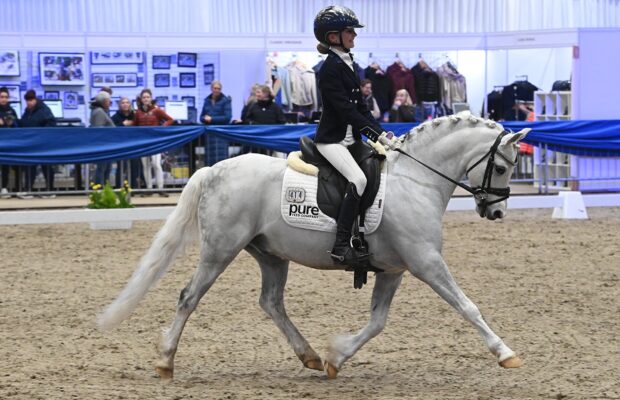At last weekend's British Dressage national convention (19-20 November), Ferdi Eilberg began by focusing on the fundamental dressage building blocks — from the right approach to take with young horses, to the value of having a plan
Guiding young horses
Ferdi Eilberg’s first presentation at the British Dressage national convention last weekend (19-20 November) — focusing on the fundamentals of dressage training — featured his son Michael aboard the four-year-old Rousseau mare Rihanna (pictured, above).
He began by explaining that young horses “shouldn’t be dominated; just guide them”.
As Michael was warming her up and encouraging the hot mare to relax, Ferdi commented on a slightly scrappy upwards transition: “The transition to canter isn’t about putting the perfect canter aid on, it’s about balancing the horse and encouraging them forward,” he said.
The horse was excitable in the area to start with and Ferdi reminded the audience that this isn’t necessarily a bad thing.
“Horses with the energy and the quality to be the best grand prix horses are often very hot youngsters, which can be challenging, but this is what we look for,” he said. “Early on, we focus on the horses’ basic ability to go and stop — both between and within the paces. With most horses, when they start learning to go more forward, they’ll fall on the forehand; there are only a few natural athletes who can maintain the power from behind and not go on the forehand.”
Good management is key to young horses’ physical and mental wellbeing at the Eilberg yard.
“As soon as they are safe we ride them on the sand track around the edge of the field,” he said. “Until then, we have the walls in the indoor school to help contain them.”
Don’t be over-greedy
For the riders’ part, Ferdi stressed that always having a plan is paramount.
“We have to have the constant desire to want to develop the horse,” he said. “It’s a process of challenge, achievement, result. Without challenge there can’t be improvement at the other end.”
The pair played with counter-canter, and the mare changed in front as she struggled to balance her expressive canter.
“Try using shallow loops to introduce counter-canter rather than going large,” advised Ferdi.
“The two corners in an arena that’s 20m wide come up very sharp for a green horse and require quite a high degree of balance.”
He also advised not to be too greedy with a generous, talented horse.
“If a horse is naturally balanced, don’t get carried away with the movements and move on a bit swift just because the horse is talented and naturally balanced. Give it time for the body to consolidate and the muscles to build. It’s the correctly-developed muscles that will protect the joints and the ligaments from being hurt — and that takes time.
Like this? You might also enjoy reading these:
25 signs you’re an incurable dressage diva/divo
Gareth Hughes: 12 things riders need to know about changes
Stretching: how and when
“Stretching a green horse in canter can be very difficult,” advised Ferdi. “Normally, when you give a young horse the rein and it will fall back to trot. Rihanna is exceptional as she has such good natural, uphill balance, so she can take the stretch.
“You must not shorten the neck too much in front before horses learn to collect behind. They need to step forward with the hindleg into the contact.”
He also offered advice to those whose horses aren’t relaxed or well enough behaved to perform a stretch when warming up.
“Be brave with the stretch at the end of the session when the horse is quieter and not so likely to be naughty,” he suggested. “They must learn to stretch the neck muscles. Once they are confident doing that, they will come back to take the contact better.
“Stretching the neck muscles immediately has a great influence on stretching the back muscles — this is a lot of this horse’s work at the moment because from nature she offers to be together.
“So she has to stretch the muscles because the body is more comfortable coming together. When we first lunged this horse in canter she looked like she’d been trained for two years. Her balance was exceptional.”
Look out for part two of Ferdi’s finest advice from the British Dressage national convention, coming later this week




